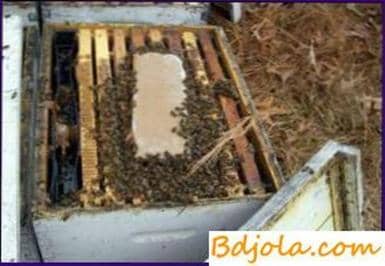
If the season has developed unsuccessfully and the bees do not even stock up their food for the winter, they have to feed sugar syrup. However, it is better to give them honey. Experienced beekeepers in this case always keep it in reserve. But bees can live on sugar forage. The syrup is prepared as follows: in a liter of boiled water dissolve a kilogram of sugar, cool it to a temperature of 35-40 њ C and give the families in the feeding trough about 3-4 kg for the night.

Bees quickly detect a sweet liquid and transfer it to the nest. They remove excess water from the syrup, enrich it with enzymes – substances that accelerate the process of converting complex cane sugar into simple ones, that is, they work on it just like over nectar. After a day or two or even the next day, the syrup is given again and so on until the food reserves are brought to the minimum standard (16-18 kg).
When processing syrup, bees spend a lot of energy and wear out significantly. Therefore, additional feed should be given in the first half of August, so that summer bees take part in its processing, which still will not survive until winter. Bees can be made easier by adding a little honey to the syrup, which will improve the quality of the feed.
To give sugar syrup it is necessary and when the prepared forage contains an excess of mineral salts, causing intestinal disorders in bees.
Bees willingly collect not only floral nectar, but also the so-called pad – sweet secretions of aphids and other sucking insects that live on the branches and leaves of trees, feed on their juices. A hot and dry summer favors their reproduction. There are so many falls on the leaves that it falls like drops of rain on the ground.
Above the fall, the bees work just like they do on nectar. However, not all complex substances in it are susceptible to the action of the digestive juice of bees.
Honeydew honey is much richer in flower mineral salts. Its color is dark, like molasses, with a greenish tint. It is thick and viscous. Bees that do not suffer from intestinal conquests can eat free honey, but since these diseases are quite common, even the presence of a padilla in honey is harmful to bees, especially in winter, when they are unable to fly out to free the intestines. Therefore, for the winter, the honey from the nests is removed from the nests and replaced with a flower honey.
For a man, padovy honey, on the contrary, is considered very useful, especially it is recommended to the pulmonary patient. In Europe, it is in high demand and valued much more expensive than the flower. Beekeepers specially bring bees to sources of honeydew honey. He learned how to predict how the weather is. Travel to the mead is planned in advance.
In August, the main concern of the beekeeper is to create favorable conditions for growing large numbers of bees for the winter. At that time, they combine two or all other weak families, who have worked on the honey collector and who have not had time to grow stronger, have not grown up in layers, late swarms. “Two or three families connected together,” Academician AM Butlerov pointed out, “can give a completely safe hive for the winter, and individually each of them, being weak, would either die in the winter or come out in the spring just a little.”
Beekeepers finally prepare the nests for the winter. In multi-hull beehives, two cases are left. The lower free compartments, from which the bees carried the honey upwards, are removed. The upper shells should be full of honey.
In such two-story nests, as in hollows, there are abundant supplies of honey. Bees in winter will not move horizontally, as in all single-hull beehives, and vertically – from the bottom up. Two tiered nest close to the natural one also because bees in it can easily move from one street to another. Promotes this free space between the bodies. It has a positive effect on the course of wintering and is equivalent to labyrinths and passages, which usually occur in the nest of wild bees, and allows them to move freely in the club.
In 12-frame hives and sun loungers, nests are collected from frames containing 2.5 kg of honey. They replace the honeycomb with a lighter weight. With such stocks of food, bees in winter are not hungry.
Что добавлять пчелам в сироп. Приспособление пчел.
Young Beekeeper